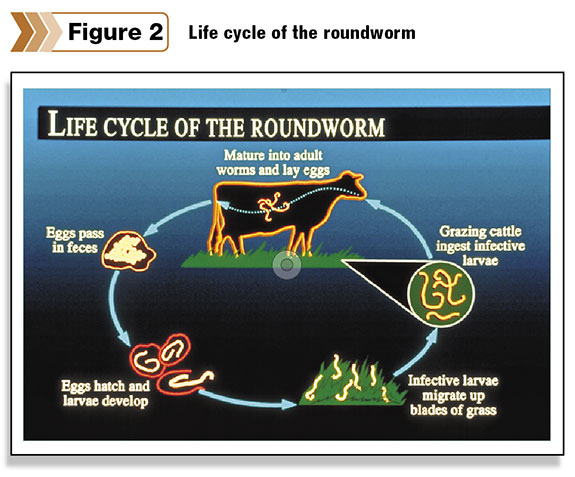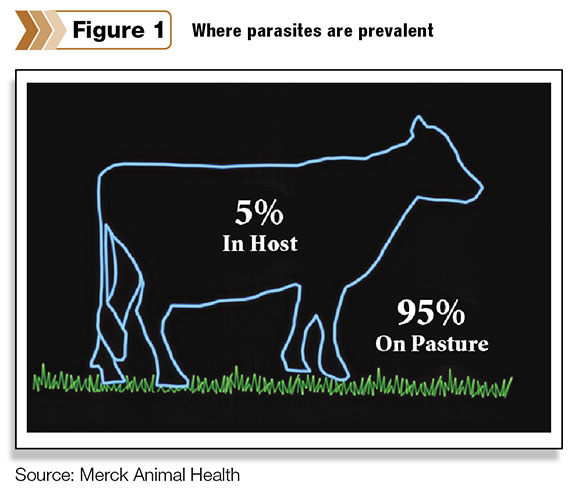
Life cycle and prevalence of parasites
The life cycle of most internal parasites starts with cattle consuming infective larva (L3 – third-stage larva) while grazing.
The larva mature in the digestive tract and start producing eggs that travel through the feces onto the pasture.
Under the right temperature and humidity, the eggs develop into infective larva.
These larva crawl up blades of grass, are consumed by the animal and the life cycle is repeated. (See Figure 2. above)
It’s also important to understand where parasites are most prevalent.
Only about 5 percent are in the host animal, while about 95 percent are found on the pasture in the form of eggs and larva. (See Figure 1.)

Effects of drought on parasites
As a general rule of thumb, when the temperature is warm and humidity is high, the eggs will hatch and mature at an accelerated rate.
Simply stated, when the pasture is at its best, the number of parasites is generally highest.
However, when the weather is hot and dry, as in a drought, many of the eggs and larva do not survive.
Logic tells us that lower parasite numbers on the pasture should benefit the animal since it faces less exposure.
During a drought, however, the animal is most likely in a challenged nutritional state, and the immune system’s ability to deal with parasites may be lowered.
As a result, the number of parasites in the animal may be lower, but their impact may be greater.
Deworming during a drought also may increase the number of resistant parasites on the pasture.
For example, the extremely dry weather may have decreased the number of viable larva and eggs on the pasture, but once cattle are dewormed, any surviving parasites passing eggs are most likely from resistant parasites. This increases the number of resistant parasites on the pasture.
All populations have a few parasites that carry genes of resistance to one or more of the three classes of anthelmintics.
Avermectin resistance in the U.S. now is widespread according to the most recent National Animal Health Monitoring Service (NAHMS) parasite survey conducted by the U.S. Department of Agriculture.
An animal also may become more heavily parasitized in a drought than in a normal year. Grass generally grows where the most moisture is located.
During a drought, this will be the most heavily grazed area with the most ideal environment for parasite survival and transmission.
Research has shown that as cattle concentrate in areas where grass remains, the parasite burden in those areas increases and results in higher parasite levels in those animals.
Concurrent use of products
A lot of research has been done in Australia on the concurrent use of two or more classes of anthelmintics. Dr. Robert Dobson, a parasite modeler, and others developed a parasite modeling program that predicts the development of parasite resistance based on weather and frequency of anthelmintic usage.
The model also looked at single-class anthelmintic use vs. rotational-class anthelmintic use vs. concurrent use of two or more anthelmintic classes.
The conclusion was that concurrent use of two or more classes of anthelmintics can reduce and/or delay the development of anthelmintic resistance for several years as compared to repeated use of a single class of anthelmintic or rotational class of anthelmintic use.
Several years of observational research have shown that concurrent use of multiple anthelmintic classes appears to be one of the most effective and efficient ways to delay and/or manage parasite resistance.
Deworming tips
Consider the following best practices for an effective deworming program:
- To determine if deworming is necessary, know the parasite burden by conducting a fecal egg count on the herd.
- If deworming is necessary, consider the concurrent use of two or more classes of anthelmintics. (See info about anthelmintic classes and products below.)
- Conduct a fecal egg count reduction test (FECRT) to ensure deworming was effective and that parasite resistance is not being spread on that pasture.
- Work with a cattle parasitologist or veterinarian to develop a deworming program for your operation. No two ranches or farms are alike, and an anthelmintic program should be developed for each operation based on the goals and needs of the producer.
- Always make deworming and animal health decisions based on the best science available.
Dr. Newcomb is a technical services manager for Merck Animal Health. He lives in Mississippi and can be contacted at 662-609-6364.
References omitted due to space but are available upon request. Click here to email an editor.
Anthelmintic classes and products
Macrocyclic lactones
- Dectomax doramectin
- Ivomec ivermectin
- Cydectin moxidectin
- Eprinex eprinectin
- Generic ivermectins
Benzimidazoles
- Safe-Guard/Panacur fenbendazole
- Valbazen albendazole
- Synanthic oxfendazole
Imidazothiazoles
- Rumatel morantel tartrate
- Levamisole









